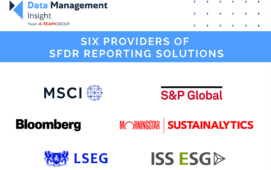
Sustainability tech platform Clarity AI is providing the infrastructure and analytics behind a new tool that’s helping LSEG’s financial institution clients comply with European ESG reporting rules that came into effect this week.
SFDR Reporting Professional Powered by Clarity AI has been created to enable compliance with the new Level 2 Sustainable Finance Disclosure Regulation. It will be available to thousands of clients of LSEG’s Refinitiv business, enabling them to aggregate portfolio-level data on funds and assets and complete SFDR disclosure templates. The underlying instrument-level data can also be used to rebalance portfolios, interrogate their performance and create risk-management strategies.
The new service developed out of a long-tern relationship between Clarity AI and Refinitiv, one of the major data suppliers to the New York-based tech firm’s ESG data processing and analytics products. Clarity AI adapted its own SFDR reporting service to work with Refinitiv’s huge data sets, according to Daniel González Gómez, Clarity AI’s global head of distribution partnerships.
“Refinitiv was working on an SFDR product already but when we showed them ours, they realised that a joint product would have broader coverage, so we thought ‘why don’t we do something together’,” González Gómez told ESG Insight.
That “something” has materialised as an augmentation of Refinitiv’s fundamental data with Clarity AI’s directly sourced and estimated ESG data, with the addition of its artificial intelligence-based analytics and data processing capabilities.
“It means we can make the most of the tools and the technology that we can offer, adding value to Refinitiv clients, and at the same time we can leverage the market presence of Refinitiv’s client base,” González Gómez added.
Sustainability Level
SFDR’s second phase was implemented on Monday after its initial rules came into force in 2021. The update requires institutions to declare their financial products as either wholly comprising sustainability-focused companies and assets – called Article 9 funds – having a sustainable element (Article 8) or no ESG mandate at all (Article 6).
According to LSEG’s Lipper data there are 10,300 European Article 8 funds, which oversee €5.2 trillion in assets, and 1,221 Article 9 funds with €478 billion under management.
Before the scope of the so-called Level 2 update was tightened last year, companies had clamoured to register their funds as Article 9, betting that the higher sustainability ranking would make them more attractive to investors. But rising concern about greenwashing and the growing impatience of regulators around the world towards mislabelling has prompted a large proportion of fund managers to reclassify their products as Article 8.
The first disclosures under Level 2 SFDR are not expected until the second quarter. At that time another plank of the regulation will kick in: the provision of disclosures on the effects that firms’ investments are having on the wider world through the Principle Adverse Impacts (PAI) indicators. These are 16 predefined tests, including the carbon emissions and intensity of investments, against which funds must gauge their performance.
Cloud and API
Clarity AI’s ESG data capabilities are applied to more than 320,00 funds, 50,000 companies, 198 national issuers and 188 local governments.
The new tool leverages data from each party and combines it with Clarity AI’s estimated data, which is derived using artificial intelligence to fill gaps in the data record and utilises feeds from other vendors, including CDP.
Clarity AI runs machine learning algorithm-based reliability checks to ensure clients have the best source of information and once the data sets are aligned, Clarity AI’s analytical tools are applied in the cloud before the packages are sent to clients via APIs.
González Gómez said the partnership has been created with expansion in mind to meet further anticipated updates to SFDR, including a broadening of the PAIs and a new product labelling regime.
“We are working on expanding the product to provide more transparency, for example, so that clients can see the raw data behind each of the PAI indicators for each company,” he said.
Clarity AI and LSEG Create Compliance Tool for Updated SFDR
Sustainable investment data and tech company Clarity AI is providing the infrastructure and analytics behind a new tool that’s helping LSEG’s financial institution clients comply with European ESG reporting rules that came into effect this week.
SFDR Reporting Professional has been created to enable compliance with the new Level 2 Sustainable Finance Disclosure Regulation. It will be available to 40,000 clients of LSEG’s Refinitiv business, enabling them to aggregate portfolio-level data on funds and assets and complete SFDR disclosure templates. The underlying instrument-level data can also be used to rebalance portfolios, interrogate their performance and create risk-management strategies.
The new service developed out of a long-term relationship between Clarity AI and Refinitiv, one of the major data suppliers to the New York-based tech firm’s ESG data processing and analytics products. Clarity AI adapted its own SFDR reporting service to work with Refinitiv’s huge data sets, according to Daniel González Gómez, Clarity AI’s global head of distribution partnerships.
“Refinitiv has an SFDR product already but when we showed them our product, they realised that ours had much better coverage, so we thought ‘why don’t we do something together’,” González Gómez told ESG Insight.
That “something” has materialised as an augmentation of Refinitiv’s fundamental data with Clarity AI’s directly sourced and estimated ESG data, with the addition of its artificial intelligence-based analytics and data processing capabilities.
“It means we can make the most of the tools and the technology that we can offer, adding value to Refinitiv clients, and at the same time we can leverage the market presence of Refinitiv’s client base,” González Gómez added.
Sustainability Level
SFDR’s second phase was implemented on Monday after its initial rules came into force in 2021. The update requires institutions to declare their financial products as either wholly comprising sustainability-focused companies and assets – called Article 9 funds – having a sustainable element (Article 8) or no ESG mandate at all (Article 6).
According to LSEG’s Lipper data there are 10,300 European Article 8 funds, which oversee €5.2 trillion in assets, and 1,221 Article 9 funds with €478 billion under management.
Before the scope of the so-called Level 2 update was tightened last year, companies had clamoured to register their funds as Article 9, betting that the higher sustainability ranking would make them more attractive to investors. But rising concern about greenwashing and the growing impatience of regulators around the world towards mislabelling has prompted a large proportion of fund managers to reclassify their products as Article 8.
The first disclosures under Level 2 SFDR are not expected until the second quarter. At that time another plank of the regulation will kick in: the provision of disclosures on the effects that firms’ investments are having on the wider world through the Principle Adverse Impacts (PAI) indicators. These are 16 predefined tests, including the carbon emissions and intensity of investments, against which funds must gauge their performance.
Cloud and API
Clarity AI’s ESG data capabilities are applied to more than 300,00 funds, 50,000 companies, 198 national issuers and 188 local governments.
The new tool leverages data from each party and combines it with Clarity AI’s estimated data, which is derived to fill gaps in the data record and utilises feeds from other vendors, including CDP.
Clarity AI runs reliability checks to make sure clients have the best source of information and once the data sets are aligned, Clarity AI’s analytical tools are applied in the cloud before the packages are sent to clients via APIs.
González Gómez said the partnership has been created with expansion in mind to meet further anticipated updates to SFDR, including a broadening of the PAIs and a new product labelling regime.
“We are working on expanding the product to provide more transparency, for example, so that clients can see the raw data behind each of the PAI indicators for each company,” he said.
Subscribe to our newsletter




